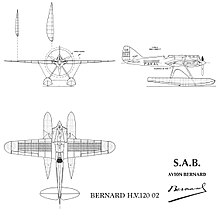
The Latécoère 28 was a long distance monoplane aircraft designed and produced by the French aircraft manufacturer Latécoère.

The Farman F.220 and its derivatives were thick-sectioned, high-winged, four engined French monoplanes from Farman Aviation Works. Based on the push-pull configuration proven by the F.211, design started in August 1925 and the first flight of the prototype was on 26 May 1932. The largest bomber to serve in France between the two world wars was the final F.222 variant. One variation was intended to be an airliner.

The Avia BH-21 was a fighter biplane designed and produced by the Czechoslovakian aircraft manufacturer Avia. First flown in January 1925, it served an important role in securing Czechoslovak national security during the Interwar period.
The Arsenal VB 10 was a French fighter-interceptor aircraft developed during and shortly after World War II. It was a low-wing monoplane with retractable tailwheel undercarriage and of largely orthodox configuration. The ultimate product of a design that began with the Arsenal VG 10 prior to the war, the VB 10 added a second engine behind the cockpit which drove a second propeller, coaxial with and contra-rotating to the propeller driven by the engine in the nose.

The Latécoère 521 was a French six-engined double deck flying boat designed and manufactured by Pierre-Georges Latécoère. At the time of its completion, it held the distinction of being the largest aircraft to be built in France as well as one of the first large passenger aircraft capable of flying trans-Atlantic routes.
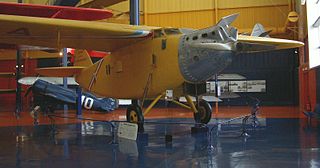
The Bernard 190 or Bernard-Hubert 190 was a French airliner of 1928. It was a high-wing cantilever monoplane of conventional configuration, based on the Bernard 18. Compared with its predecessor, it kept the same basic design but featured redesigned tail surfaces, an enlarged cabin, and offered its flight crew a completely enclosed cockpit. Also like its predecessor, the basic airliner model provided the basis for a long-range aircraft to be used in record attempts, the 191GR.
The Dewoitine D.33 was a single-engine low-wing all-metal monoplane aircraft designed and produced by the French aircraft manufacturer Dewoitine. It is best remembered for setting a long-distance world record on its maiden flight in 1930.

The Farman F.300 and F.310 were trimotor monoplane airliners designed and produced by the French aircraft manufacturer Farman Aviation Works.

The Wibault 280-T was a monoplane trimotor airliner designed and produced by the French aircraft manufacturer Wibault. Designed to accommodate up to 12 passengers in its largest variant, development of the aircraft was financially backed by the Penhoët shipyards, which led to the aircraft alternatively being referred to as 'Penhoët Wibault'.

The Lioré et Olivier H-190 was a biplane flying boat aircraft designed and produced by the French aircraft manufacturer Lioré et Olivier.

The Dewoitine D.513 was a 1930s prototype French monoplane fighter designed and built by Dewoitine.

The Romano R.90 was a prototype single-seat French floatplane fighter of the 1930s. A single example of the R.90 was built, but the type did form the basis of the Romano R.83 and Romano R.92 fighters which were built in secret for the Spanish Republicans during the Spanish Civil War.
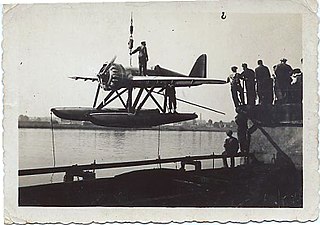
The Bernard H.V.40 was a racing seaplane designed by Société des Avions Bernard for the French government to compete in the 1929 Schneider Trophy.
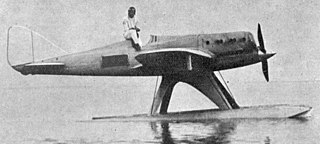
The Bernard H.V.41 was a racing seaplane designed by Société des Avions Bernard for the French government to compete in the 1929 Schneider Trophy.

The Bernard H.V.42 was a racing seaplane designed by Société des Avions Bernard for the French government for use of the French Schneider Trophy team.
The Stampe et Vertongen RSV.22 was a training biplane produced in Belgium in the 1920s.
The Bernard 80 GR was one of three types built by different French constructors in response to a government call for an aircraft capable of setting new long-distance records. A single engine monoplane with a crew of two, the 80 GR set an absolute record for flight over a closed circuit in April 1931, covering 8,960 km (5,569 mi). Modifications led to a new designation as the Bernard 81 GR but no more records were set despite several attempts.
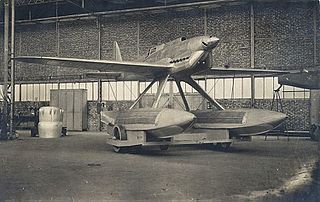
The Bernard H.V.220 was a 1930s French racing seaplane and the last attempt by Bernard compete in the Schneider Trophy race. Delays caused by engine problems meant the aircraft was abandoned and never flown.

The Potez-CAMS 161 was a large, French six-engined flying boat airliner, designed to operate on the North Atlantic routes that were opening up in the late 1930s. Its development was almost halted by World War II. Just one was built and partially tested before its destruction by Allied forces near the war's end.
The Nieuport-Delage NiD 450 was a French racing floatplane, originally intended to compete for the 1929 Schneider Trophy. After the French decided not to participate that year, the type was used as the NiD 650 to speed the development of the proposed entrants to the 1931 event, the NiD 651 and NiD 652. Delays in producing the latters' engines left these unflown.


